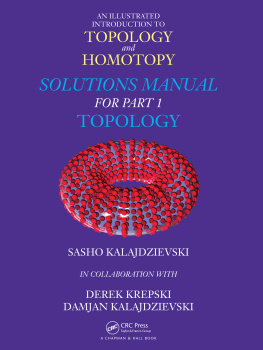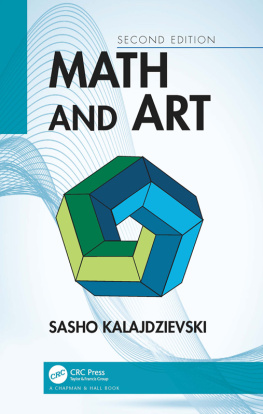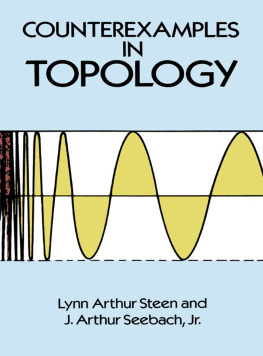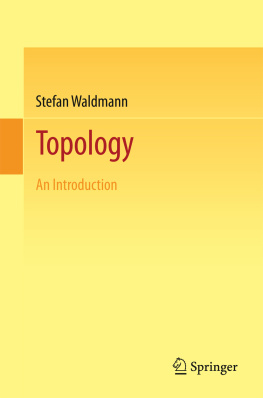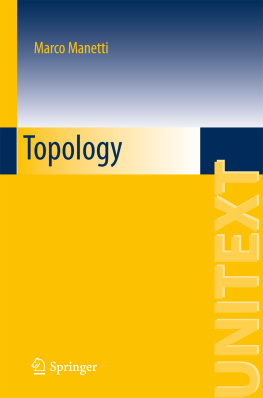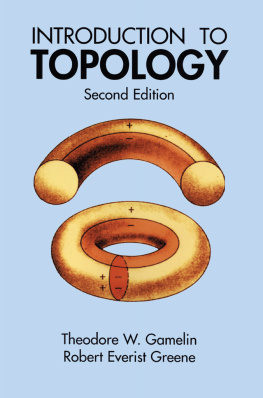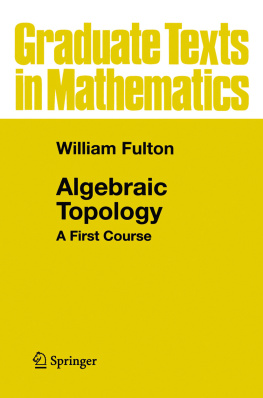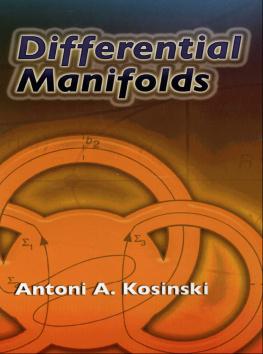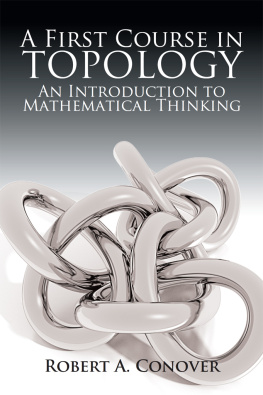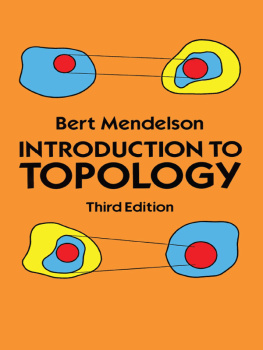
AN ILLUSTRATED
INTRODUCTION TO
TOPOLOGY
and
HOMOTOPY
SOLUTIONS MANUAL
FOR PART 1
TOPOLOGY
SASHO KALAJDZIEVSKI
IN COLLABORATION WITH
DEREK KREPSKI
DAMJAN KALAJDZIEVSKI

CRC Press
Taylor & Francis Group
6000 Broken Sound Parkway NW, Suite 300
Boca Raton, FL 33487-2742
2018 by Taylor & Francis Group, LLC
CRC Press is an imprint of Taylor & Francis Group, an Informa business
No claim to original U.S. Government works
Printed on acid-free paper
International Standard Book Number-13: 978-1-138-55346-0 (Hardback)
This book contains information obtained from authentic and highly regarded sources. Reasonable efforts have been made to publish reliable data and information, but the author and publisher cannot assume responsibility for the validity of all materials or the consequences of their use. The authors and publishers have attempted to trace the copyright holders of all material reproduced in this publication and apologize to copyright holders if permission to publish in this form has not been obtained. If any copyright material has not been acknowledged please write and let us know so we may rectify in any future reprint.
Except as permitted under U.S. Copyright Law, no part of this book may be reprinted, reproduced, transmitted, or utilized in any form by any electronic, mechanical, or other means, now known or hereafter invented, including photocopying, microfilming, and recording, or in any information storage or retrieval system, without written permission from the publishers.
For permission to photocopy or use material electronically from this work, please access www.copyright.com (http://www.copyright.com/) or contact the Copyright Clearance Center, Inc. (CCC), 222 Rosewood Drive, Danvers, MA 01923, 978-750-8400. CCC is a not-for-profit organization that provides licenses and registration for a variety of users. For organizations that have been granted a photocopy license by the CCC, a separate system of payment has been arranged.
Trademark Notice: Product or corporate names may be trademarks or registered trademarks, and are used only for identification and explanation without intent to infringe.
Visit the Taylor & Francis Web site at
http://www.taylorandfrancis.com
and the CRC Press Web site at
http://www.crcpress.com
PREFACE AND ACKNOWLEDGEMENT
This solution manual accompanies the first part of the book An Illustrated Introduction to Topology and Homotopy by the same author. Except for a small number of exercises in the first few sections, we provide solutions of the (228) odd-numbered problems appearing in the first part of the book (Topology). The primary targets of this manual are the students of topology. This set is not disjoint from the set of instructors of topology courses, who may also find this manual useful as a source of examples, exam problems, etc.
The help of the two collaborators was invaluable to me. However, all typos and errors are mine. Comments related to the book or to the solution manual will be appreciated; please email to ; corrections are posted there.
I am thankful to Mladen Despic for his help.
SK
Chapter 1: Sets, Numbers and Cardinals
1.1 Sets and Numbers.
Solutions of some exercises
Given a set X, show that the relation is an order of the set of all subsets of X. For which sets X is this order linear?
Solution. If A, BX are such that AB and AB, then there is bB such that bA. Consequently B is not a subset of A, and hence is antisymmetric. If ABC then obviously AC, and so is transitive.
If X has at least two elements, say a and b, then neither {a} {b} nor {b} {a}, so the order is not linear. On the other hand if X has at most one element, then the only subsets of X are X and , and we then readily see that the order is linear.
Describe a linear order over (a) the set 2, and (b) the set 2.
Solution for (a). Define (n,m) < (p,q) if n < p or (n = p and m < q). The parentheses in the preceding sentence are to guarantee there is unique interpretation of the statement that defines <. It is left to the reader to prove this relation is antisymmetric and transitive.
Show that if is an equivalence relation over a set X, then every two equivalence classes are either disjoint or equal.
Solution. Suppose [x] and [y] are two equivalence classes, and suppose [x][y]. Then there is a[x][y]. Take any z [x]. Then axz, and hence az. On the other hand, a [y] implies that ya. The transitivity of applied to ya and az yields yz. Hence z [y]. We proved that [x] [y]. By the symmetry of the argument, it follows that [y] [x]. Hence [x] = [y].
Let X be a non-empty set and let f: XY be any mapping. Show that uv if and only if f (u) = f (v) defines an equivalence relation over X.
Solution. (i) Reflexivity: uu for every u, since f(u) = f(u) for every u. (ii) Symmetry: Suppose uv. Then f(u) = f(v), hence f(v) = f(u), hence vu. (iii) Transitivity:
Suppose uv and vw. Then f(u) = f(v) and f(v) = f(w). Hence f(u) = f(w), and we conclude that uw.
1.2 Sets and Cardinal Numbers
Solutions of the odd-numbered exercises
Let X be an infinite set. Show that for every finite subset A of X,X \ A = X. Show that there is a subset B of X such that B= 0 and such that X \ B = X.
Solution of the first claim. Denote A = {a1, a2,, an}. Use the assumption that X is infinite and induction to construct an infinite countable subset
A1 = {a1, a2,, an, an+1,} of X. The mapping f(ak) = ak+n defines a bijection from A1 onto A1 \ A = {an+1, an+2,}. Then the mapping to g: XX \ A defined by
g(x)={f(x)ifxAxifxXAis a bijection.
Let a=A1, B=B1, let S be the set of all mappings AB, and let S1 be the set of all mappings A1B1. Show that S1 = S.
Solution. By assumption there exist bijections : AA1 and : B B1. Define :5 S1 as follows: for every fS, (f): A1B1(f) = f1. Notice that (f): A1B1.
We now check that is a bijection.
One-to-one: Suppose (
Next page
